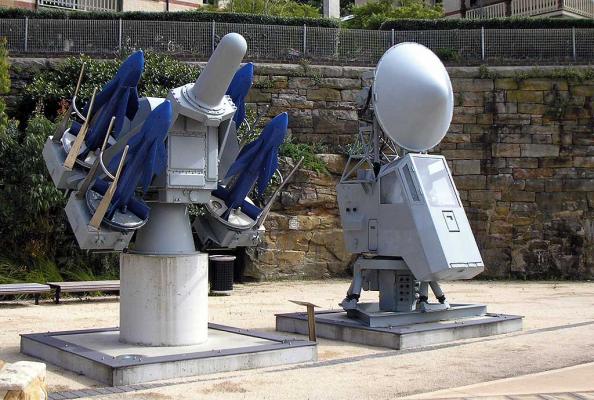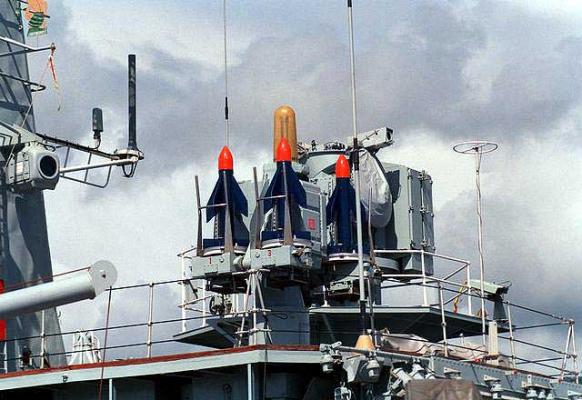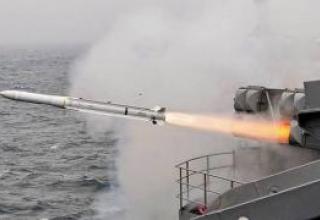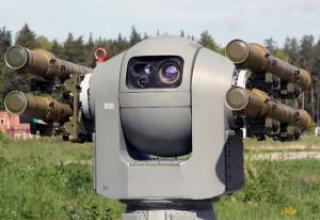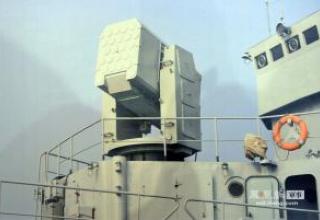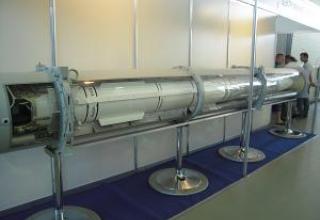Sea Cat short-range anti-aircraft missile system (SAM) is designed to fight low-level subsonic means of air attack at ranges up to 6 km and altitudes up to 3 km. Sea Cat missile system of various modifications was in service with the Royal Navy of Great Britain from 1961 to mid-80s, it was equipped with ships of almost all classes. At the present time it was removed from the British Navy and replaced by the Sea Wolf SAM system.
The complex was designed by Shorts Brothers (now Thales Air Defence Ltd - Belfast Northern Ireland). Testing of the first version of the complex, designated GWS-20, as part of the Decoy frigate began in 1961.
During its long service, the complex has been repeatedly upgraded - Sea Cat SAM is part of the marine anti-aircraft systems of several modifications: GWS-20 , GWS-21 , GWS-22 and GWS-24 . In 1970, the SAM controls were developed with the use of solid-state modules, which allowed to reduce their weight and dimensions by 2/3. As a result it was possible to place the complex on small patrol boats, on hovercrafts. A helicopter version of the complex, named Hellcat, has been developed. A ground version of the Tigercat short-range anti-aircraft system has also been developed on the basis of Sea Cat SAMs (see photo). The Tigercat system has been adopted by the armed forces of Brazil, Iran and Nigeria.
The complex was widely exported and equipped with the ships of the naval forces of Australia, Germany, Sweden, Brazil (frigates of Niteroi class), Chile (frigates of Leander class of British construction), Nigeria (frigates of Vosper Mk9 class), Indonesia (frigates of Ahmad Yani class) and other countries. In the 1990s, a programme was implemented to modernize the fire control system of Sea Cat complexes in service with the Brazilian and Chilean navies. At present, the system has been removed from service almost everywhere or is being replaced by more modern and efficient systems. In particular, a program is being implemented to replace the Sea Cat complex in the armament of Indonesian frigates Ahmad Yani on Mistral SAM systems and Brazilian Niteroi - on Albatros-Spada.
Composition:
There are two known modifications of the GWS-20 SAMs - for destroyers and for patrol ships. They use a single Sea Cat SAM and have identical construction and operation schemes. The difference is in the design of some elements of SAMs and launchers (it is designed for 4 missiles for destroyers and 12 missiles for patrol ships). According to specialists, the placement of two LLRS launchers on a patrol ship creates a sufficient stock of missiles and does not require them to be delivered from the ship's holds as an destroyer.
The complex's SAM control facilities include:
- the target and missile escort post,
- guidance counting and solving device,
- go-ahead station
- remote control of the launcher.
These devices are mounted on an azimuthally rotating platform and on a launcher (radio command transmission station).
Both versions of the SAMs are equipped with detection and target designation radars, as well as target identification and target designation devices installed on ships and included in the general fire control system of the ships. The Sea Cat operator, located at the main fire control point of the ship, selects a target to be fired according to the detection and identification means radar and remotely deploys the SAM system azimuth to the target, thus providing target designation.
Escort post has a wide-angle binocular sight (vizier), designed to "capture" and follow the target, as well as a tracker of the SAM. Optical axis of this sight can be turned by the operator in angular and azimuthal planes with the help of two handles. The right handle also has a joystick for steering the Zoom while aiming. Together with the axis of the sight, the launcher guides are also remotely turned. In the version for patrol ships the escort post was replaced by a device with binocular sight, mounted on a light pedestal with an elastic base. The upgraded Sea Cat escort post is equipped with a Marconi Elliot Avionics variable-focal length TV device type 323, which provides automatic tracking of the ZUR track.
The launcher in both versions of the complex is stationary (the base is attached to the ship's deck at a certain place). It makes it possible to make launches from open end length guides at variable angles given by electro-hydraulic guidance mechanisms. The starter unit is charged manually by means of a remote command from the control panel - the guides are given a vertical position for charging. The manual charging time of the quadruple starting unit is 40s (other sources: 3 min). To the launcher on the destroyer missiles are fed from the cellars with a winch. Some of their stock can be stored in GRP containers on deck. To protect against seawater and weather factors, each RSD is covered with an elastic plastic jacket that can be kept in place before launch. The weight of the PU in the combat position is 4.7 t.
For installation on small patrol boats, on hovercrafts, instead of a quadruple launcher, a much lighter PU of 1.270 t has been developed.
Sea Cat subsonic, single-stage directional control is built according to the aerodynamic scheme "rotary wing" (see the scheme). It is equipped with a two-mode RDTT. It has no detachable parts in flight. When flying to the maximum range it uses passive part of the trajectory. It is equipped with radio command televisions using the "cover the target" method.
The missile consists of compartments: nose fairing with infrared non-contact fuse device, combat unit, electronic guidance equipment, rotary wing drives, RDTT marching mode, RDTT launch mode and engine nozzles. The ZUR compartments are fastened to each other by spring locks, a reliable electrical connection between them is provided by spring end contacts that rest on the appropriate contacts of the printed assembly.
The swiveling wings (60° front edge angle) are made of glass fabric impregnated with resins and filled with rigid foam. On the front and end edges of all wings are placed the sensitive elements of the shock detonator, and on two of them, in addition, the antennas of the guidance radio receiver. Stabilizers are located in planes offset by 45° from the wings. On all stabilizers, which have a similar design to the wings, made sockets for tracers (usually use two tracers). The steering machines of the swivel wings are driven by a hydraulic drive, which acts on the exhaust gases of the march RDTT passing through a hydraulic pressure accumulator. The fuel of the starting and marshalling RTDT is burned out in series.
There are two versions of Sea Cat SAMs: Mod.0 is equipped with a 15.5 kg (2.5 kg of explosives) combat unit, Mod.1 with a 27.5 kg (19 kg of explosives) combat unit. It was reported about the development and testing of Sea Cat-2 SAMs with supersonic flight speed increased to 6 km of target acquisition height and an effective altitude control system allowing the missile to fly up to 6 m above the sea surface, which increased the effectiveness of the complex against cruise missiles.
In addition to GWS-20, the following versions of Sea Cat are known:
- GWS-21 is an all-weather SAM equipped with I/J range guidance radar. The target detection range is up to 7.5 km.
- GWS-22 is the most common version of Sea Cat SAMs. It is equipped with an MRS-3 fire control system and a Type 909 radar. J-band with target detection range up to 16 km.
- GWS-24 is a system specially designed for armament of Type-21 frigates, the WSA-4 fire control system is combined with the Type-912 detection radar (British analog of the Italian RTN-10 radar). This powerful I-band radar provides detection of "aircraft" type targets at ranges up to 40 km and "cruise missile" type targets at ranges up to 20 km.
Characteristics:
| Range of fire, km | 6.5 |
| Missiles flight speed | 0.95М |
| The length of the rocket, m | 1.48 |
| Body diameter, mm | 190 |
| Wingspan and stabilizers, mm | 650 |
Testing:
Currently, there are no reliable data on the use of the Seacat complex, which is part of the Iranian frigates Vosper Mk 5, during the Iran-Iraq war, so the only confirmed case of combat use of this complex should be considered the Anglo-Argentine conflict of 1982. By that time, the Seacat SAM system was an outdated system, but it was part of the air defense assets of a large number of British ships involved in the conflict (for example, the Hermes aircraft carrier equipped with GWS-22 systems).
During the conflict, there were numerous uses of various modifications of the Seacat SAM system. However, despite the fact that the official British statistics record a number of shot down Argentine aircraft, the real combat effectiveness of the complex was low. It should also be noted that the British frigate "Ardent", sunk by Argentine aircraft as a result of a bomb attack, was armed with GWS-24 "Seacat" SAM system. The high reliability of the Seacat missile and the whole complex can be attributed to the positive aspects. In particular, the fire control system of the complex reliably operated in narrow strait zones, against the background of heavily crossed rocky coastline, in conditions of powerful radio electronic interference, ie where complexes with radar guidance principle were ineffective.
Sources:
- С.А. Пересада "Зенитные ракетные комплексы" Военное издательство Министерства обороны СССР, Москва, 1973 г.
- Royal Australian Navy Gun Plot/Seacat missile system
- El misil de defensa de punto Seacat
- Seegestьtzte Luftabwehr Lenkwaffen und -Systeme / Seacat

